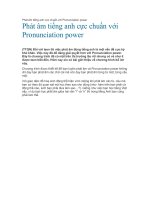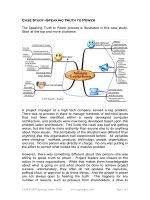PRONUNCIATION POWER ppt
Bạn đang xem bản rút gọn của tài liệu. Xem và tải ngay bản đầy đủ của tài liệu tại đây (1.18 MB, 52 trang )
Are they speaking English?
Are they speaking English?
Why is pronunciation important ?
Why is pronunciation important ?
“
“
I went to the US in 1996 for the first time.
I went to the US in 1996 for the first time.
Whenever I spoke to a person in America, they
Whenever I spoke to a person in America, they
kept asking me : "what ? what ?". I would
kept asking me : "what ? what ?". I would
repeat my sentence again and again. Finally,
repeat my sentence again and again. Finally,
they would say "Ah-ha!" and then repeat my
they would say "Ah-ha!" and then repeat my
sentence, using exactly my words ! It was
sentence, using exactly my words ! It was
embarrassing! I knew my words and grammar
embarrassing! I knew my words and grammar
were correct but nobody would understand me
were correct but nobody would understand me
just because of my pronunciation. I am very
just because of my pronunciation. I am very
motivated to learn English and the right
motivated to learn English and the right
pronunciation and phonetics now
pronunciation and phonetics now
” Mike said
” Mike said
“
“
I meet many people with high level
I meet many people with high level
of grammar and vocabulary in English at
of grammar and vocabulary in English at
work. However, they can't express
work. However, they can't express
themselves correctly because of too many
themselves correctly because of too many
bad mistakes in pronunciation. I keep
bad mistakes in pronunciation. I keep
telling them that the key to the good
telling them that the key to the good
comprehension and speaking in English
comprehension and speaking in English
is good pronunciation but they don't
is good pronunciation but they don't
seem to be much worried about that.
seem to be much worried about that.
”
”
Chantal said
Chantal said
“
“
Pronunciation is important because it makes your first
Pronunciation is important because it makes your first
impression.
impression.
Many English learners ignore pronunciation. They can
Many English learners ignore pronunciation. They can
communicate in class, so they think they are good
communicate in class, so they think they are good
enough. They say "I don't need to study pronunciation.
enough. They say "I don't need to study pronunciation.
I just want to communicate in English."
I just want to communicate in English."
They think that they communicate in English because
They think that they communicate in English because
they can communicate with their teacher and other
they can communicate with their teacher and other
students. You have to remember :
students. You have to remember :
* Your teacher has been listening to bad pronunciation
* Your teacher has been listening to bad pronunciation
for years. He or she can understand it much easier than
for years. He or she can understand it much easier than
the average person.
the average person.
”
”
Shilly said
Shilly said
* Other students are usually from the same
* Other students are usually from the same
country as you. therefore, they speak English
country as you. therefore, they speak English
like you and they make the same mistakes. So
like you and they make the same mistakes. So
it's easy for them to understand you.
it's easy for them to understand you.
The good news is that you can work on your
The good news is that you can work on your
pronunciation until you speak
pronunciation until you speak
"understandable and pleasant English" (good
"understandable and pleasant English" (good
pronunciation). You can learn the sounds of
pronunciation). You can learn the sounds of
English, listen to recordings, watch English
English, listen to recordings, watch English
language television, etc. But first you have to
language television, etc. But first you have to
realize there is a problem ! Most English
realize there is a problem ! Most English
learners don't.
learners don't.
VOCABULARY OF ORGANS OF SPEECH
VOCABULARY OF ORGANS OF SPEECH
-
alveolar
alveolar
-
nasal
nasal
-
cavity
cavity
-
velum
velum
-
uvula
uvula
-
palate
palate
-
pharynx
pharynx
-
epiglottis
epiglottis
-
larynx
larynx
-
glottis
glottis
-
vocal
vocal
[æl'viələ]
[æl'viələ]
['neizəl]
['neizəl]
['kæviti]
['kæviti]
['vi:ləm]
['vi:ləm]
['ju:vjulə]
['ju:vjulə]
['pælət]
['pælət]
['færiηks]
['færiηks]
[,epi'glɔtis]
[,epi'glɔtis]
['læriηks]
['læriηks]
['glɔtis]
['glɔtis]
['voukl]
['voukl]
(thuộc) ổ răng
(thuộc) ổ răng
(thuộc) mũi
(thuộc) mũi
hố hốc, ổ, khoang
hố hốc, ổ, khoang
vòm miệng mềm
vòm miệng mềm
lưỡi gà (ở trên cổ họng
lưỡi gà (ở trên cổ họng
)
)
vòm miệng
vòm miệng
hầu, họng
hầu, họng
nắp thanh quản
nắp thanh quản
thanh quản
thanh quản
thanh môn
thanh môn
liên quan đến
liên quan đến
phát âm
phát âm
Place of articulation
Place of articulation
Manner of
Manner of
articulation
articulation
Bi-
Bi-
labial
labial
Labio
Labio
-dental
-dental
Dental
Dental
Alveolar
Alveolar
Palato-
Palato-
alveolar
alveolar
Palatal
Palatal
Velar
Velar
Glottal
Glottal
Stop
Stop
pb
pb
td
td
k
k
g
g
Fricative
Fricative
fv
fv
θ
θ
ð
ð
sz
sz
ʃʒ
ʃʒ
h
h
Affricate
Affricate
tʃd
tʃd
ʒ
ʒ
Nasal
Nasal
m
m
n
n
ŋ
ŋ
Liquid
Liquid
l
l
r
r
j
j
Glide
Glide
w
w
Explanation of the table
Explanation of the table
Place of articulation: vị trí cấu âm
Place of articulation: vị trí cấu âm
Bilabial
Bilabial
2 môi
2 môi
Labio
Labio
-dental
-dental
mặt nhai của hàm răng trên chạm vào phía trong
mặt nhai của hàm răng trên chạm vào phía trong
môi dưới
môi dưới
Dental
Dental
đầu lưỡi chạm vào bề mặt trong của hàm răng trên
đầu lưỡi chạm vào bề mặt trong của hàm răng trên
Alveolar đầu lưỡi chạm vào chân răng của hàm răng trên
Alveolar đầu lưỡi chạm vào chân răng của hàm răng trên
Palato- Alveolar (post-alveolar):
Palato- Alveolar (post-alveolar):
phần thân (trước) lưỡi chạm vào
phần thân (trước) lưỡi chạm vào
phần sau của chân răng.
phần sau của chân răng.
(
(
Âm ở nướu, ngạc cứng)
Âm ở nướu, ngạc cứng)
Palatal phần thân (trước) lưỡi chạm vào phần cứng của vòm miệng
Palatal phần thân (trước) lưỡi chạm vào phần cứng của vòm miệng
Velar phần thân lưỡi chạm vào phần mềm của vòm miệng
Velar phần thân lưỡi chạm vào phần mềm của vòm miệng
Glottal không khí đi từ khí quản
Glottal không khí đi từ khí quản
thoát qua 2 dây thanh
thoát qua 2 dây thanh
âm
âm
Manner of articulation: Cách thức cấu âm
Manner of articulation: Cách thức cấu âm
Stop
Stop
:
:
(âm tắc) Luồng hơi bị chặn lại hoàn toàn trước khi
(âm tắc) Luồng hơi bị chặn lại hoàn toàn trước khi
thoát ra ngoài
thoát ra ngoài
Fricative
Fricative
: (âm xát) Luồng hơi được thoát ra qua khe hở bé ở
: (âm xát) Luồng hơi được thoát ra qua khe hở bé ở
miệng
miệng
Affricative
Affricative
: (âm tắc xát) Lúc đầu luồng hơi bị chặn lại sau đó
: (âm tắc xát) Lúc đầu luồng hơi bị chặn lại sau đó
thoát ra qua khe hẹp ở miêng (sự kết hợp của
thoát ra qua khe hẹp ở miêng (sự kết hợp của
âm tắc và xát)
âm tắc và xát)
Nasal: (Âm mũi) Luồng hơi liên tục được thoát ra qua
Nasal: (Âm mũi) Luồng hơi liên tục được thoát ra qua
khoang mũi
khoang mũi
Liquid
Liquid
: (âm lỏng) Luồng hơi di chuyển
: (âm lỏng) Luồng hơi di chuyển
quanh lưỡi và thoát ra ngoài miệng
quanh lưỡi và thoát ra ngoài miệng
Glide
Glide
:
:
(Âm lướt)
(Âm lướt)
Places of articulation
Places of articulation
Bilabial:
Bilabial:
/p/
/p/
/b/
/b/
(The lips are pressed together)
(The lips are pressed together)
Labiodental fricative:
Labiodental fricative:
/f/
/f/
/v/
/v/
The lower lip is contact with the upper teeth
The lower lip is contact with the upper teeth
Dental fricative:
Dental fricative:
/θ/
/θ/
/ð/
/ð/
The tip of the tongue touches the inside
The tip of the tongue touches the inside
Alveolar- stop:
Alveolar- stop:
/t/
/t/
/d/
/d/
Alveolar- fricative:
Alveolar- fricative:
/s/
/s/
/z/
/z/
The tongue blade is pressed against the alveolar ridge
The tongue blade is pressed against the alveolar ridge
Palatal- Alveolar (post-alveolar):
Palatal- Alveolar (post-alveolar):
/
/
ʃ/ /ʒ/
ʃ/ /ʒ/
The tip or the blade of the tongue articulates with the
The tip or the blade of the tongue articulates with the
back
back
area of the alveolar ridge (the middle of the tongue against
area of the alveolar ridge (the middle of the tongue against
the area behind the alveolar ridge as it rises to the roof of the
the area behind the alveolar ridge as it rises to the roof of the
mouth or palate. )
mouth or palate. )
Palatal:
Palatal:
/j/
/j/
Raising the front part of the tongue to the palate, farther
Raising the front part of the tongue to the palate, farther
back from the alveolar ridge (The front of the tongue
back from the alveolar ridge (The front of the tongue
articulates with the domed part of the hard palate)
articulates with the domed part of the hard palate)
Velar:
Velar:
/
/
k/
k/
/g
/g
/
/
The back of the tongue is pressed against the area where
The back of the tongue is pressed against the area where
the hard palate ends and the soft palate begins
the hard palate ends and the soft palate begins
/r/
/r/
(The tip of the tongue approaches the
(The tip of the tongue approaches the
alveolar area in the way it would for
alveolar area in the way it would for
/t/
/t/
or
or
/d/
/d/
,
,
but never makes contact with any part of the roof
but never makes contact with any part of the roof
of the mouth. The tongue is curled backwards
of the mouth. The tongue is curled backwards
with the tip raised)
with the tip raised)









